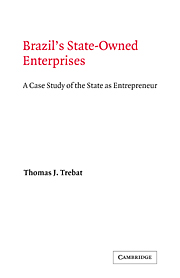Book contents
- Frontmatter
- Contents
- List of tables and figures
- Preface
- 1 Introduction
- 2 The economic role of the state
- 3 Origins of public enterprise in Brazil
- 4 The control of public enterprise in Brazil
- 5 Relationships with economic growth
- 6 Sources of growth and rates of return
- 7 Policies on pricing
- 8 The financing of public enterprise investment
- 9 Conclusions
- Appendix A Enterprises included and years covered
- Appendix B Sources and interpretation of data on public enterprises, 1965–1979
- Notes
- Selected bibliography
- Index
- Cambridge Latin American Studies
5 - Relationships with economic growth
Published online by Cambridge University Press: 27 March 2010
- Frontmatter
- Contents
- List of tables and figures
- Preface
- 1 Introduction
- 2 The economic role of the state
- 3 Origins of public enterprise in Brazil
- 4 The control of public enterprise in Brazil
- 5 Relationships with economic growth
- 6 Sources of growth and rates of return
- 7 Policies on pricing
- 8 The financing of public enterprise investment
- 9 Conclusions
- Appendix A Enterprises included and years covered
- Appendix B Sources and interpretation of data on public enterprises, 1965–1979
- Notes
- Selected bibliography
- Index
- Cambridge Latin American Studies
Summary
By most standard measures, the fifteen-year period between 1965 and 1980 witnessed as thorough – even revolutionary – a change in the structure of the Brazilian economy as any in the country's history. It was a period during which GDP expanded by 8.5% per annum, real per capita income doubled, and the output of the industrial sector practically quadrupled. All of the usual indicators of economic progress – steel production, electricity generation, auto–vehicle production, paved highways, energy consumption, imports, exports, and so on – reflect the feverish pace of economic activity in these fifteen years.
By the early 1980s, Brazil had established itself as the dominant economy in Latin America and, arguably but plausibly, the largest and most important economy in the Third World. If the status of world power still eluded it, Brazil had achieved an undeniably important position in the world economy. Almost every multinational corporation of any standing had operations in Brazil. Every large bank in the world had on its books loans to Brazil equal to a substantial proportion of its capital. Increasingly, Brazilian manufactured goods ranging from frozen orange juice to computers were penetrating world markets, large and small.
The definitive story of Brazil's economic growth from 1965 to 1980 would contain important chapters dealing with stabilization in 1965–7, rapid economic expansion through 1973, the first oil shock and the transition to slower growth from 1973 on, and – while its inception is hard to pinpoint – the gathering crisis and the restructuring of the Brazilian economy in the 1980s.
- Type
- Chapter
- Information
- Brazil's State-Owned EnterprisesA Case Study of the State as Entrepreneur, pp. 115 - 152Publisher: Cambridge University PressPrint publication year: 1983



